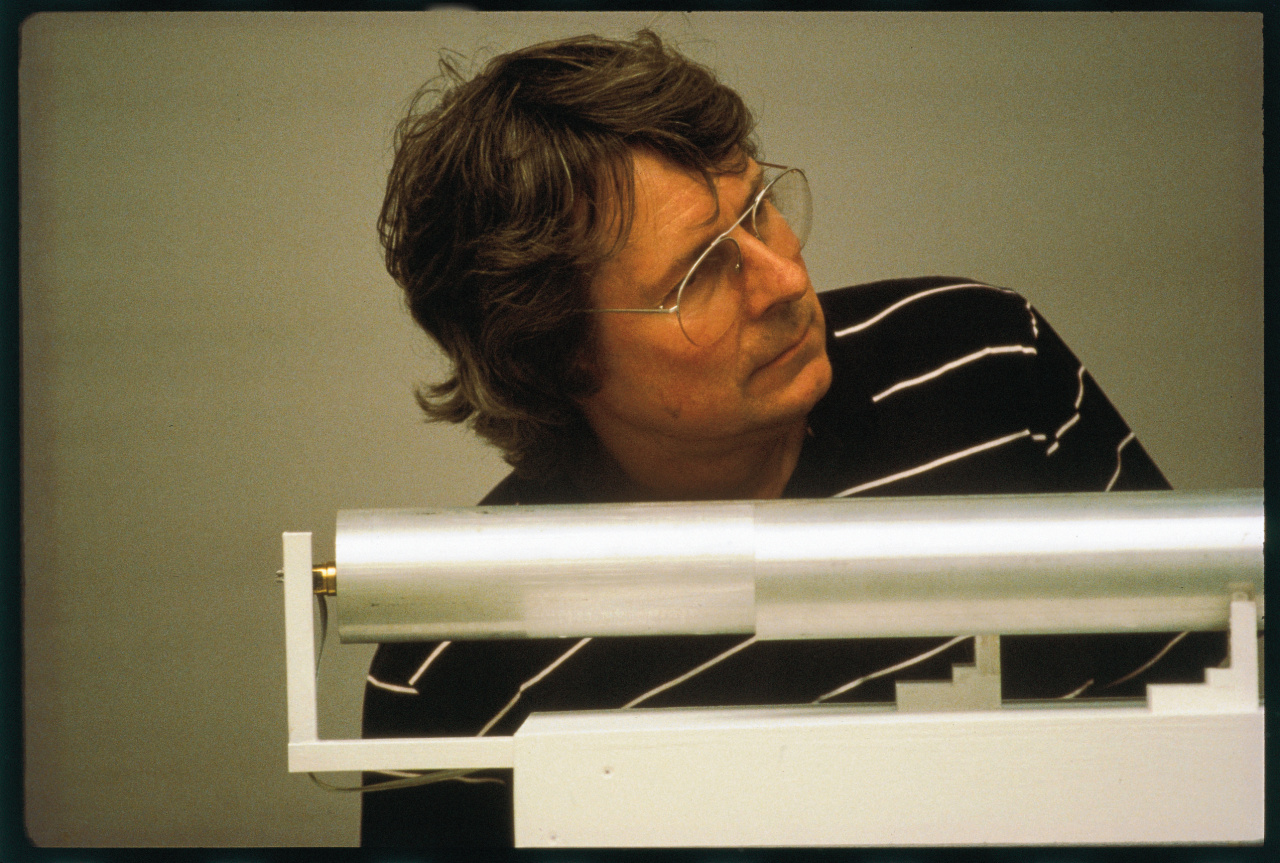Stephan von Huene
Year of birth, place
Year of death, place
Role at the ZKM
- Artist of the Collection
- Artist of the archive
Biography
Stephan von Huene was born in Los Angeles in 1932, the son of German émigrés. He attended Pasadena City College, Pasadena (1950-52) and the University of California in Los Angeles (1952-53). From 1955 he studied Painting, Drawing and Design at the Chouinard Art Institute, Los Angeles, taking a BA in Fine Arts in 1959. He subsequently returned to the University of California in Los Angeles (1963-66) to take an MA in Art and Art History. During the later 1960s and the 1970s Huene taught at universities and art schools in California, above all at the California Institute of the Arts, Los Angeles. The award of a DAAD grant in 1976 made a year's stay in Berlin possible; and in 1980 Huene moved to Hamburg. During the 1980s and early 1990s he taught at art schools and universities in Germany and Austria, on occasion as Guest Professor. From 1993 to 1996 he was a Professor at the Staatliche Hochschule für Gestaltung, Karlsruhe. Huene has received numerous prizes and awards, including the Medienkunstpreis des Siemens-Kulturprogramm (1992) and the main prize awarded by the Helmut-Kraft-Stiftung, Stuttgart (1996). Stephan von Huene lives in Hamburg.
In the very earliest of Stephan von Huene's works - the collages and images and drawings he made in the early 1960s - one already finds motifs that have continued to recur and that anticipate his later sound sculptures: for example, the use of fragments of the human figure, always defined by items of clothing, or the combination of words with expressive gestures. In 1964 Huene made his first assemblages, and his first sculptural objects using wood and leather. In 1967 Huene started making audio-kinetic sculptures: using these as mechanical bodies in sound installations, he was able to achieve startling new combinations of sound, language and space. The sophisticated mechanical and technological aspect of such works was here put to the service of artistic intentions informed by a knowledge of linguistics and behavioural psychology. Drawings too play a central role in Huene's work, both as preparatory material and as a part of the finished product, albeit hardly ever in the traditional sense of sketches and studies. In Huene's 'inter, intra- and re-active' sound installations, language serves both as a tool of communication and as a raw material - ready for transformation into sound accompanied by movement. This, however, is a transformation that only takes place in full in the presence, and through the effective participation, of the gallery visitor. Sensors capable of detecting movement and sound are activated by the presence of spectators, and these in turn set off the movements and sounds effected by the sculptures. Stephan von Huene's highly dramatic works thus appeal simultaneously to all senses.
Since 2016, the estate and library of Stephan von Huene is part of the ZKM | Karlsruhe.
Individual exhibitions (selection)
1966 David Stuart Galleries, Los Angeles
1969 Los Angeles County Museum of Art, Los Angeles
1970 Whitney Museum of American Art, New York; San Francisco Museum of Modern Art, San Francisco; Michael Walls Gallery, San Francisco
1974 Museum for Contemporary Art, Chicago
1982 Center for Music Experiments, University of California, San Diego
1983 Staatliche Kunsthalle Baden-Baden; Kestner-Gesellschaft, Hannover
1984 Museum Ludwig, Cologne; Schloss Charlottenburg, Berlin
1989 »TischTänzer«, Weißes Haus, Hamburg
1990 »Lexichaos«, Hamburger Kunsthalle, Hamburg; Louisiana Museum of Modern Art, Humlebaek
1996 »Lexichaos«, Kunststation St. Peter, Cologne
1997 »What's wrong with art?«, Galerie Kammer, Hamburg; »What's wrong with Culture?«, ACP Galerie Peter Schuengel, Salzburg
Group exhibitions (selection)
1961 Pasadena Art Museum, Pasadena
1967 Whitney Museum of American Art, New York; »American Sculpture in the Sixties«, Los Angeles County Museum of Art, Los Angeles, subsequently at Philadelphia Museum of Art, Philadelphia
1975 »Sehen um zu Hören«, Kunsthalle Düsseldorf
1976 Biennale di Venezia, Venice
1979 »Sound Sculpture«, Los Angeles County Museum of Art, Los Angeles, subsequently at PS 1 (Project Studio One), New York
1980 »Für Augen und Ohren«, Akademie der Künste, Berlin, subsequently at Musée d'Art Moderne de la Ville de Paris
1983 »Luther und die Folgen für die Kunst«, Hamburger Kunsthalle, Hamburg
1985 »Vom Klang der Bilder«, Staatsgalerie Stuttgart
1987 »Der Zauber der Medusa«, Künstlerhaus, Vienna; documenta VIII, Kassel
1989 »Maschinen Menschen«, Neuer Berliner Kunstverein, Berlin
1992 »Moving Image-Electronic Art«, Fundació Joan Miró, Barcelona
1993 »MultiMediale 3«, Zentrum für Kunst und Medientechnologie Karlsruhe; »Mediale«, Deichtorhallen, Hamburg; 3. International Biennale in Nagoya - Artec '93, Nagoya City Art Museum, Nagoya
1994 »Inventionen '94«, Festival Neuer Musik, Berlin; »Automata, World Festival Exposition MIE '94«, Nagoya; »Tage für Neue Musik«, Donaueschingen
1995 »Identità e Alterità«, Biennale di Venezia, Venice
1996 »Sonambiente«, Akademie der Künste, Berlin; »Artmedial«, Conselleria de Cultura Balear, Palma de Mallorca
[Frauke Syamken, 1997]
